Mr. Hinckley's "Air Force"
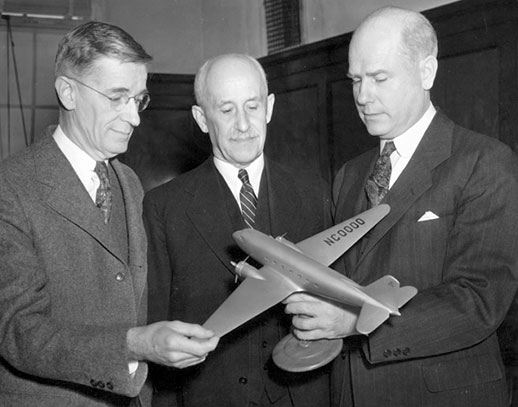
In 1938, oversight of civil aviation passed to a new independent agency, the Civil Aeronautics Authority. The second chairman of the Authority was Robert H. Hinckley, shown above with Vannevar Bush and Orville Wright.
Hinckley was the force behind the Civilian Pilot Training Program (CPTP).
Beginning on a regular basis in the 1939-40 school year, the CPTP graduated thousands of new pilots as a means of strengthening the nation for possible war.
After the Pearl Harbor attack, the program was renamed the War Training Service (WTS).
(CAA photos from Patricia Strickland's The "Putt-Putt" Air Force, a 1974 FAA publication.)
Two Important New Centers
Among the seminal events of the CAA era was the establishment of a pair of major new facilities, one devoted to research and one to a spectrum of functions.
Opened in May 1939, the Indianapolis Experimental Station was dedicated to seeking improvements in such aeronautical fields as communications, navigation, lighting, and landing systems.
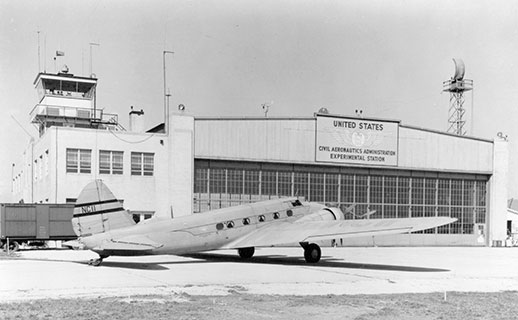
The photo above shows the station in 1946, the year in which the first radar-equipped control tower for civilian flying was unveiled there by the CAA. (Since 1940, the CAA had been redesignated the Civil Aeronautics Administration and had operated as a part of the Commerce Department.) The B-247 in the foreground was the agency's NC-11 "flying laboratory."
The Experimental Station was later renamed the Technical Development and Evaluation Center, then gradually deactivated after the establishment of a new research and testing facility in New Jersey in 1958.
In May 1946, the CAA announced the selection of Will Rogers Field at Oklahoma City as the location of its new aeronautical center. The municipal government agreed to construct an administrative building and two hangars for the agency's use.
The CAA quickly began to concentrate many aircraft maintenance and training activities at this central location.
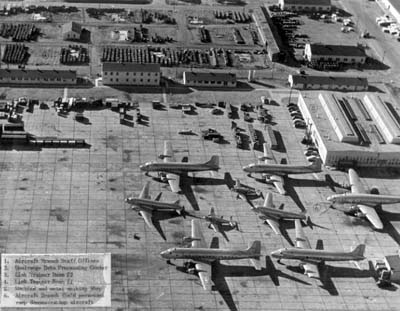
Above: an early 1950s view of part of the Aeronautical Center. The four buildings aligned in a row include (left to right) the Aircraft Branch staff office, Omnirange Data Processing Center, and two structures for Link Trainer rooms. The large building at right is the machine and metal working shop. (From album of Robert W. Swinney)
Subsequently enlarged and improved, the facility remains the FAA's principal base for training and maintenance — as well as for such varied functions as logistics, registration records, and medical research. In June 1978, it was renamed the Mike Monroney Aeronautical Center in honor of Oklahoma's noted Congressman and Senator. Monroney sponsored many important aviation laws, including the 1958 act that created the FAA.
An Airport for the Nation's Capital
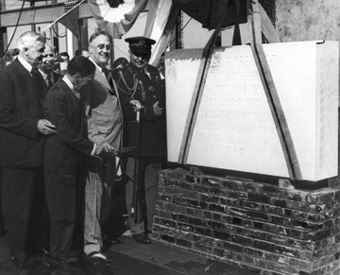 In the photo at right, President Franklin D. Roosevelt lays the corner stone for Washington National Airport in September 1940. The Civil Aeronautics Administration had begun building the facility two years earlier.
In the photo at right, President Franklin D. Roosevelt lays the corner stone for Washington National Airport in September 1940. The Civil Aeronautics Administration had begun building the facility two years earlier.
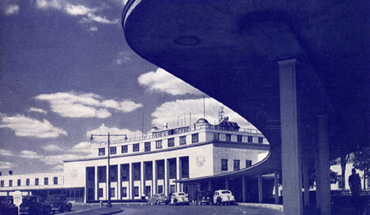 Roosevelt took a personal interest in the project, and influenced the terminal design to give it a more classical style. The President was probably responsible for inclusion of the portico shown in the view (right) of the completed structure.
Roosevelt took a personal interest in the project, and influenced the terminal design to give it a more classical style. The President was probably responsible for inclusion of the portico shown in the view (right) of the completed structure.
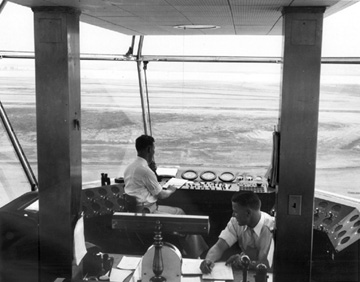 When it opened in June 1941, the "peoples' airport" was a state-of-the-art facility. The view from the tower (left) included the banks of the Potomac River, where some of some 500 acres of land had been filled to support the runways.
When it opened in June 1941, the "peoples' airport" was a state-of-the-art facility. The view from the tower (left) included the banks of the Potomac River, where some of some 500 acres of land had been filled to support the runways.
The CAA and its successor, the FAA, continued to operate National until its transfer to a regional authority in 1987. Eleven years later, the facility was renamed Ronald Reagan Washington National Airport.
A Memorable Aircraft
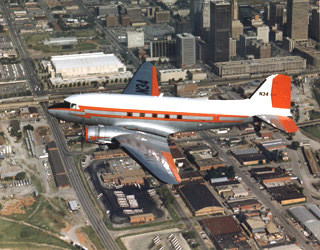 The uniquely serviceable Douglas DC-3 was a classic that achieved lasting popularity worldwide. In 1941, the CAA acquired the first of the many DC-3s that it used for flight inspection, research, and administrative transport.
The uniquely serviceable Douglas DC-3 was a classic that achieved lasting popularity worldwide. In 1941, the CAA acquired the first of the many DC-3s that it used for flight inspection, research, and administrative transport.
In the photo at right, N-34 flies over Oklahoma City decked in CAA colors.
This particular DC-3, however, belonged to the Navy before its transfer to FAA in 1963. N-34 performed quality assurance and facility certification checks on the Nation's airways before serving for several years as an FAA exhibit at air shows. Now retired from active service, it is slated for a new role as a museum display.
The Birth of FAA
As the age of jet airline travel approached, many Americans recognized the need for more concerted effort to safeguard civil aviation. A severe midair collision over the Grand Canyon in 1956 underscored this necessity. In 1958, the Federal Aviation Act created the FAA, an independent agency combining scattered safety responsibilities.
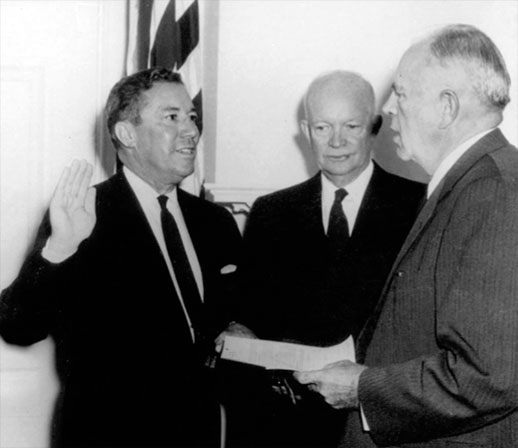
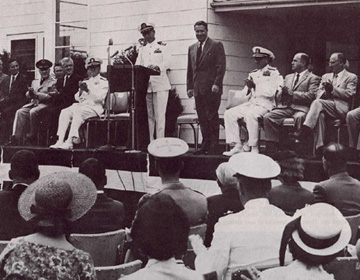 A retired Air Force general, Quesada had served as President Eisenhower's special aviation advisor. He had also headed a temporary Airways Modernization Board. One of his actions in that position was to establish the National Aviation Facilities Experimental Center (NAFEC) at a former military base in New Jersey. (This research complex is now the FAA's Technical Center.)
A retired Air Force general, Quesada had served as President Eisenhower's special aviation advisor. He had also headed a temporary Airways Modernization Board. One of his actions in that position was to establish the National Aviation Facilities Experimental Center (NAFEC) at a former military base in New Jersey. (This research complex is now the FAA's Technical Center.)
In the above photo, Quesada is standing beside a Naval officer at the NAFEC facility transfer ceremony in June 1958. The man seated second to the left of the podium is James T. Pyle, last Administrator of the CAA and soon to become the first Deputy Administrator of the nascent FAA.
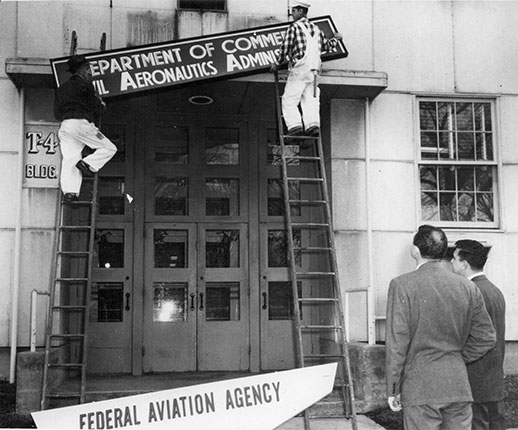
On the last day of 1958, the FAA assumed the full scope of its responsibilities, superseding the CAA and also absorbing the Civil Aeronautics Board's safety rulemaking function. The new agency possessed the authority to establish a unified civil/military National Airspace System backed by an expanded network of air navigation and air traffic control facilities.
The last word of the FAA's name changed from "Agency" to "Administration" when the organization became part of the new Department of Transportation in 1967.
Dulles International Airport
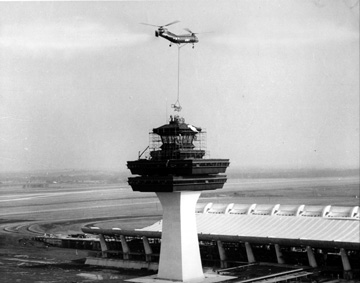 A notable project that the FAA inherited from the CAA was establishment of a second major airport to serve Washington, D.C. Construction began in September 1958, with architect Eero Saarinen providing a prize-winning design for the terminal complex.
A notable project that the FAA inherited from the CAA was establishment of a second major airport to serve Washington, D.C. Construction began in September 1958, with architect Eero Saarinen providing a prize-winning design for the terminal complex.
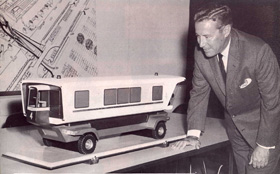 At left, FAA Administrator Elwood "Pete" Quesada inspects a model of a mobil lounge, an innovative concept aimed at speeding the flow of boarding and deplaning passengers at the new airport.
At left, FAA Administrator Elwood "Pete" Quesada inspects a model of a mobil lounge, an innovative concept aimed at speeding the flow of boarding and deplaning passengers at the new airport.
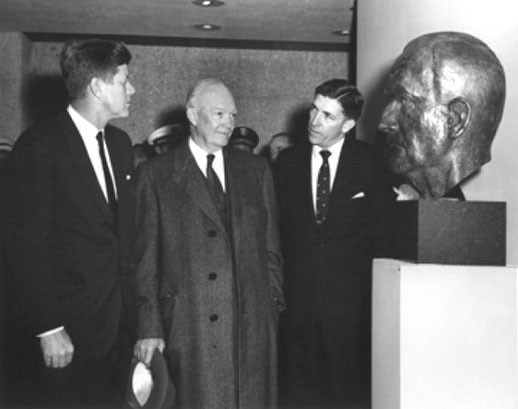
In 1959, President Eisenhower named the still-incomplete airport after his late Secretary of State, John Foster Dulles. In this scene from the facility's opening ceremony in 1962, Eisenhower admires a statue of Dulles in the company of President Kennedy and FAA's second Administrator, Najeeb E. Halaby.
Last updated: Tuesday, November 16, 2021
